I cast off in Port Mansfield, Texas, a little before 9 a.m. on a muggy June morning under mostly clear skies and a light, variable breeze. The Texas 200 is an annual run of scores of boats, most of them under 20′ and many homemade, through the bays and cuts between the southern Texas mainland and its barrier islands. It was my second time participating. I’d completed the roughly 200-mile course in 2017 (see “The Texas 200: A trial by water”). Although the winds in this part of Texas at this time of year can range from dead calm to powerful squalls, the event’s timing typically avoids the last of the winter northers and the first of the summer hurricanes, and the norm is moderate-to-stiff winds on the quarter or beam for the entire 200 or so miles.
When I cleared Port Mansfield, the wind in Red Fish Bay remained light but became steady from astern. A scattering of cumulus clouds hung just above the horizon. It was already hot, but the breeze coming across the water was refreshing. The water gurgled against the hull and trailed away in a flat, weak wake. Half a dozen other sails dotted the offing ahead, and two boats astern still worked their way out through the fluky breezes in the harbor.
ARR & ARR, my homemade Flint, a 14′ 10″ skiff designed by Ross Lillistone, was loaded far more lightly than she had been in 2017, and with the modifications I had made to the boat and rig since then, including the addition of buoyancy bags, and my gained experience in these waters, I was confident that we’d make it to the finish at Magnolia Beach.
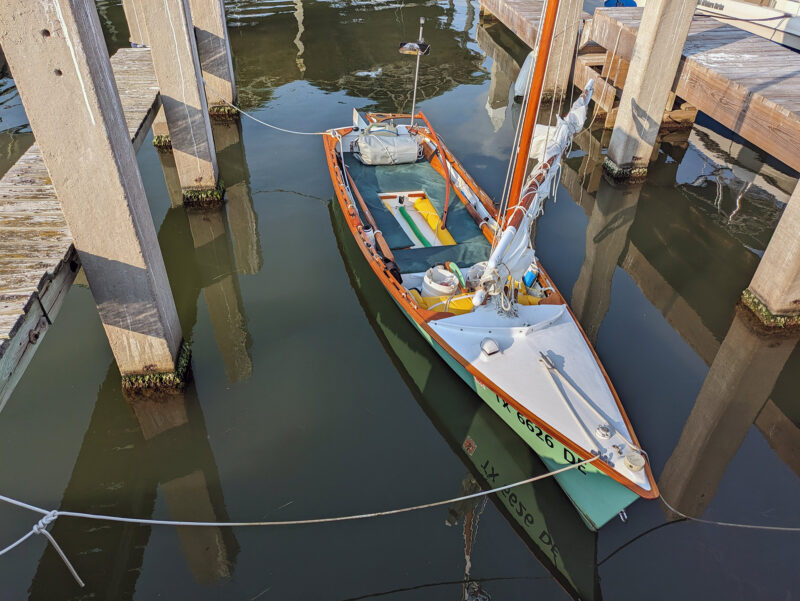 Roger Siebert
Roger Siebert ARR & ARR lies tied up in her slip in Port Mansfield on the morning of Day 1 of the Texas 200. Other than a dry bag, the 3-gallon jug of drinking water lashed in the sternsheets, and the gear necessary for working the boat, everything is stowed inside the buoyancy compartments. Buoyancy bags fill the spaces beneath the side benches and in the forward part of the cockpit, and a rowing mirror is fastened high on the stern light pole.
The wind was forecast to increase through the afternoon, so I had prepared my homemade sea anchor—a 2-gallon plastic bucket with a few holes in the bottom and a rope bridle—by fastening its rode to the foredeck cleat and running it back through the bow chock and into the cockpit where I could easily reach it. If I needed to reef the sail, I could drop the sea anchor and it would hold the boat head-to wind and waves.
Despite the forecast, within half an hour, the breeze had fallen away almost entirely. The sail flogged and the sheet dipped to within inches of the water’s surface. Long swaths of floating seagrass streaked away across the water until they vanished into the glare of the shimmering mirror-like bay. I tired of pulling up and resetting the daggerboard and rudder blade every time they became fouled with grass, so I raised the board until I estimated only its curved lower leading edge was exposed, then pulled the rudder blade up to 45 degrees so that it would cast the grass off astern on its own. I lay to leeward in the sternsheets, my legs stretched out on the side bench, and let gravity put a belly in the sail. ARR & ARR moved a little faster, but so little that I wrote it off as imagination. But, speed or no speed, at least I was able to let the boat tend to herself.
I could have moved faster under oars, but spring had been particularly busy at work, and I had fallen out of rowing shape. The forecast for the coming week promised calms for every morning, and I wouldn’t be able to row multiple hours for five straight mornings. I wanted to save my best rowing for day four, the day on which I’d need to cover the most miles, 42 nautical miles from Camp Three at Mud Island to Camp Four at Army Hole, and for which the current forecast was calling for the least amount of wind.
After only 15 more minutes of creeping along under sail, the sun’s heat felt suffocating, with my long sleeves, long pants, black neoprene booties, safety harness, PFD, and neck gaiter pulled up over my nose and ears, so I sat up, staying on the boat’s leeward side to keep shape in the sail, and tried to fit myself entirely within the shadow of my wide-brimmed straw hat.
A nearly opaque softball-sized white cannonball jellyfish swam past, easily outpacing me, its bell pumping rhythmically, each pulse bunching its short, thick fringe of stingers.
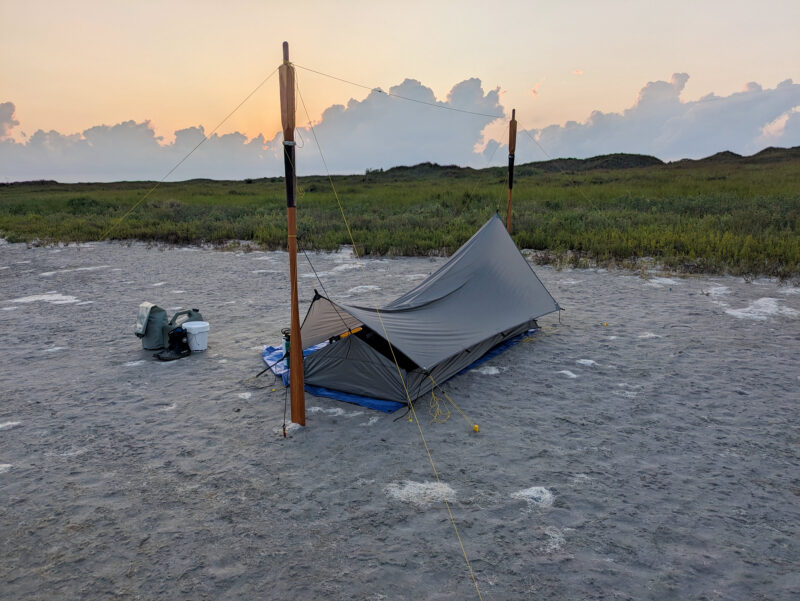 Roger Siebert
Roger Siebert Sunrise on Day 2 at Camp 1 in the Land Cut and my tent was looking good. The ultralight net bivy has solid panels at the head and foot that, together with the fly, give the occupant privacy, but at the expense of airflow. A small tarp, folded in half, served as a footprint for the tent and, spread out, provided a convenient base on which to handle gear while keeping it out of the sand and mud.
Over the handheld VHF clipped to my PFD, the Coast Guard warned small craft to take shelter everywhere from Port O’Connor—some 150 miles away and close to the end of the Texas 200—to Corpus Christi—at almost the midway point of the route. Powerful thunderstorms were building all along that stretch of the coast. Over the next 30 minutes the cumulus clouds in the northern sky grew and coalesced into a single thick, dark cover dumping a dense curtain of rain. I was still roughly 50 miles from Corpus Christi, and I hoped the clouds were gentler outlying cells and not part of the main line of storms.
The clouds and rain grew closer, and the boats a mile or more ahead turned almost in unison to starboard, their sails instantly changing from lazy, sunlit bellies into frenzied, thrashing sheets, some visibly shrinking into smaller and smaller versions of themselves as, I assumed, their skippers made swift use of their roller furling.
I tossed the bucket sea anchor overboard and slacked the downhaul and halyard to reef. In the time it took to pull in and tie my tack reef line to its cleat on the boom, the wind had accelerated from 5 knots to 35, and within seconds the glassy bay had been whipped up into a steep chop of 2′ to 3′ waves. The wind jerked the boom and clew reef line from my hands. The wind was more than all three reefs could handle. I dropped all sail, pulled the yard and boom into the cockpit, dragged the remaining belly of the sail in from the bay, and bent to the oars. All I could hope for was to keep the bow pointed toward the waves.
Within minutes the waves were more than 3′ high, steep, and breaking at their tops. The rode pulled taut, the dragging bucket just visible as a pale green cylinder beneath the waves. It was holding us into the wind and waves better than I had expected, and a single pull on one oar or the other corrected the yaw from the steeper waves. I had only tried the bucket sea anchor once before, in relatively gentle conditions in my local lake months earlier. Now, in this far stronger wind, its performance was far more impressive.
Five or six miles dead astern lay Port Mansfield, a tiny stretch of one- and two-story buildings still cast in sunlight. In my rowing mirror, a narrow band of blue sky appeared on the horizon beyond the storm clouds. This would be short-lived, and I had plenty of room to drift downwind. All I had to do was focus on the pattern of the waves and my oar strokes.
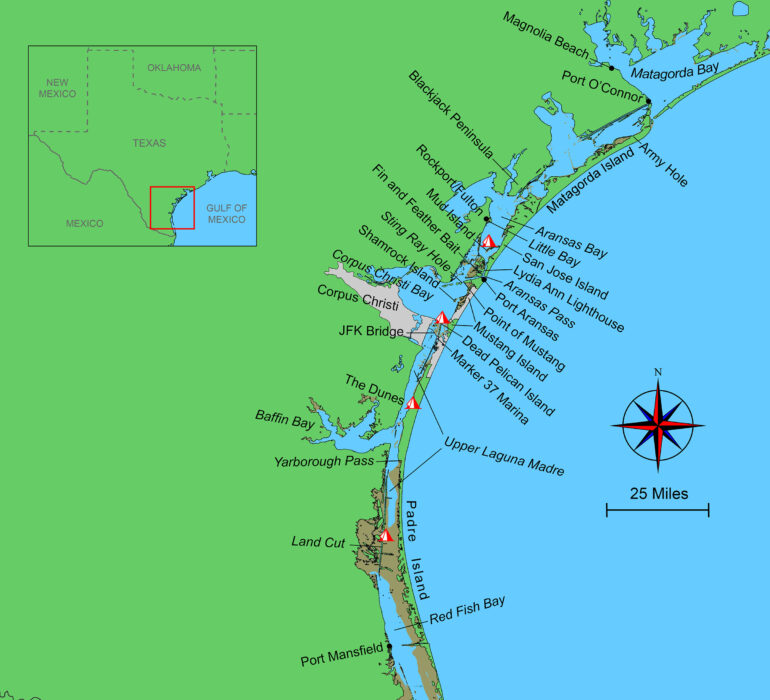 Roger Siebert
Roger Siebert.
Ten minutes later, a whooshing roar grew behind me. A breaking wave gushed out from the gunwales, lifting ARR & ARR above a trough nearly 4′ below. The bow pitched downward and jarred into it, but I felt no spray on my back. Another wave broke beneath us, and a third. Sets of three breaking waves almost 4′ tall every few minutes became the norm. Less than 1⁄2″ of water lay in the cockpit. I was grateful for this little boat’s sheer and flared-V bow, and for the years I had had familiarizing myself with her abilities. If I had been loaded as heavily as I had been in 2017, with no sea anchor and little experience, I would likely have swamped or capsized.
Some 45 minutes later, the bucket dragged deeper beneath the surface, its color more green than white and its shape less defined. The winds weakened, and eventually the waves waned.
The sun returned in all its overwhelming oppressiveness. Other boats in the area tentatively set sail again. Cathy and Chris’s Highlander yawl, SAMUEL VIMES, which had ridden out the squall under mizzen alone about 1⁄4 mile northeast of me, made headway again under full sail. I set a double reef and pulled in the bucket sea anchor but made no significant headway. I shook out one of the reefs, but still made little headway. I set full sail and made only 1 or 2 knots. The waves were still settling, but the wind had fallen away to a mere breath. After the waves finally faded away to match the lack of wind, it was as if nothing had happened.
By late afternoon, the wind had risen again, but without the storms, reaching only 15 knots with gusts to 20. At the northern end of Red Fish Bay, what had been low dunes and shrubbery, barely discernable on the horizon, closed in until becoming only a 100-yard gap between stretches of mudflats punctuated with a few beaches backed with saltwater-tolerant succulents. I had entered the Land Cut.
The flat water and stiff wind were tempting. I sat on the windward gunwale and hooked my feet beneath ARR & ARR’s hiking strap. I didn’t intend to hike out, but I wanted to be ready, just in case. Since my difficulties in 2017, when I had capsized doing this exact thing, I had modified my sheet-lead from a three-to-one purchase to two-to-one so that I could spill wind more rapidly, and with the boat less heavily laden this year, she was altogether more responsive.
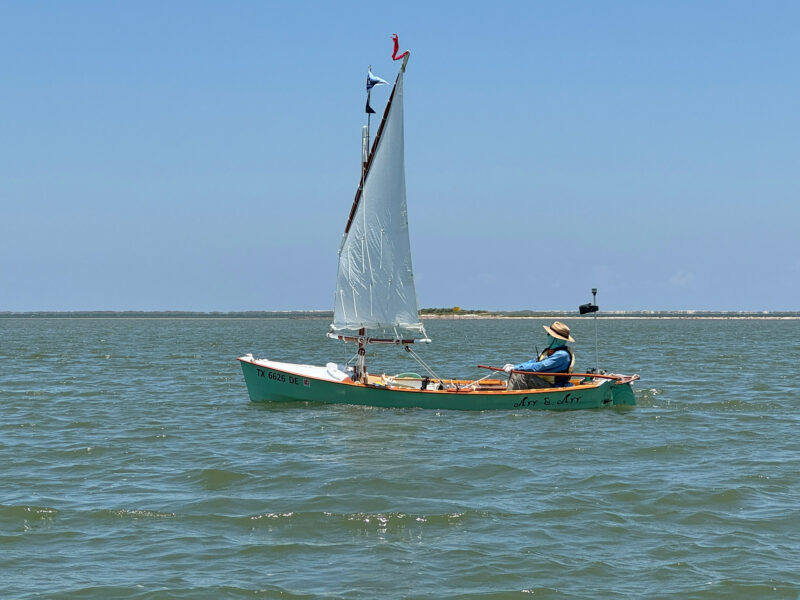 Bob Rambo
Bob RamboI approached Baffin Bay with ARR & ARR under a single reef, passed by the last of the spoil islands, and entered open water to reach all the way to Padre Island. With neither bimini nor other means of providing shade, I covered myself from head toe to avoid getting a severe sunburn during my five days under the harsh Texas summer sun.
I sailed past SAMUEL VIMES. Cathy and Chris had pulled up on a narrow beach and were tucking a reef into their main. I should probably have joined them but, thinking that the first night’s camp was close, I decided instead to keep spilling air when necessary. I had another 6 miles to go, and I was exhausted by the time I finally beached ARR & ARR in a stretch of mud along with the 50 or so other boats that had made it to the first camp out of the 70 that had launched. The others had either turned back or been rescued.
After 10 hours of baking under the searing sun, battling a windstorm, and struggling over-canvased in a stiff breeze, I was so tired that I didn’t want to eat, but I knew I needed to. While I set up camp, I nibbled on precooked tuna, rehydrated rice, and a dense, flat piece of bread. The starches made me want more water, which was also a good thing. My one-person ultralight bivy was still new to me and I was experimenting with the setup. Designed for backpacking, it came without poles, relying instead on a camper having trekking poles. On the boat I would normally have had at least a boathook and possibly other poles such as my push-pole, but I had left these behind to reduce my gear and weight and, instead, had decided to use my oars for tent poles. I set the blades on the dense sand and strung stretched guylines and a central line between them. Then, with the oars upright, I strung the bivy tent between them.
Only one boat had landed farther north than I had, and its skipper and two teenaged crew were securing their boat and setting up camp. The rest of the boats lay stretched out to the south in what seemed a never-ending forest of masts. The smell of the loamy, mucky mix of the tidal flats drove home just how remote this camp was.
By the time my shelter was ready, the sun had set. But there was little change in the temperature. Inside the bivy it was still unbearably hot so, after changing into dry clothes, I stayed outside in the night for another hour, tending to camp chores, and writing in my journal. Finally, at around 10, the tent became bearable and with a slight breeze wafting through and the sound of the water gently lapping at the beach just yards from my camp, I fell asleep.
I rose when my watch showed 4:30. The waxing crescent moon had set well before midnight, and with my phone turned off to save power and the bivy’s fly blocking my view of the stars, the watch was my only way of knowing that first light was near.
It took me far too long to break camp. It was only my second time using the oars for poles and I had been rather too zealous with the number of lines and hitches. By the time I had everything down and packed away, three hours had passed.
I topped off my water bottles from my nearly-full 3-gallon jug and added an electrolyte mixture to one. I drank a cup of instant coffee and ate granola with raisins, pecan pieces, and rehydrated powdered milk, devouring it all within minutes.
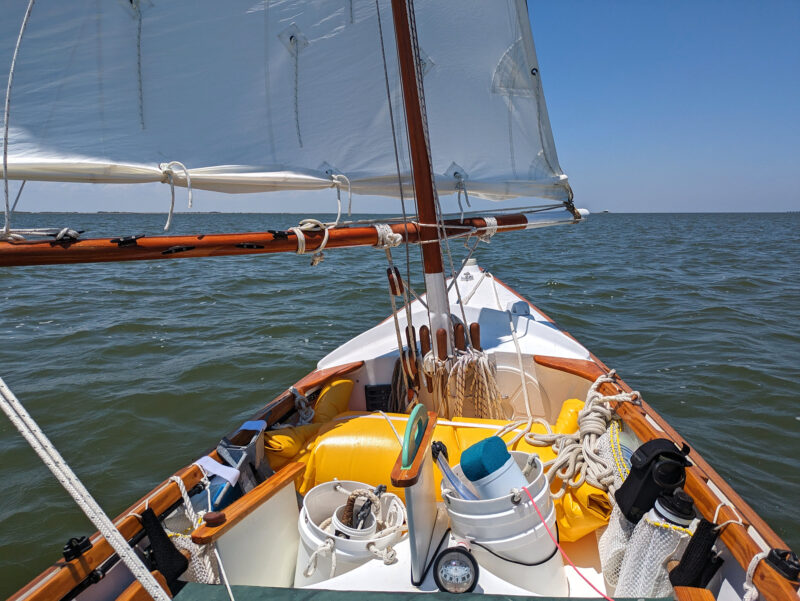 Roger Siebert
Roger SiebertARR & ARR’s forward cockpit area—shown here on the approach to Baffin Bay—accommodated, to port, a 2-gallon bucket holding the anchor rode, its 100′ of three-strand nylon line coiled around a central tube, which itself holds 8′ of chain. The anchor was secured to the port inwale with two hook-and-loop straps. To starboard was another 2-gallon bucket for serious bailing, and inside of it, my 2-gallon-bucket sea anchor with its rope bridle, and a smaller bailer and sponge. A large yellow buoyancy bag filled the remaining forward cockpit space. Net pockets hanging beneath the inwales held everything else from water bottles to cell phone. Critical gear such as the phone and a monocular were also tethered to the boat.
I made a final sweep of the campsite and spotted an 18″ boat fender lying in the glasswort, beach daisies, and other undergrowth about 5 yards above the edge of the beach. The fender’s ridged, once-white surface was soiled gray-brown. I stepped tentatively through the sprawling knee-high greenery—watching out for rattlesnakes—plucked it out of the scrub and brought it back to the boat. I washed it in the Land Cut and stowed it on board.
I set off from the beach, one of the last to do so. The morning was more torturous even than the first. The air was still, the water like glass. I had little hope of catching up with my fellow voyagers. But, again, I was reluctant to row. It was only about 30 miles to the second camp and there were many hours ahead of me. So, as I had done the day before, I lay back and waited for the breeze.
Before long the thin seat cushions had become uncomfortable, and I pulled out the rowing seat cushion. In time that, too, became uncomfortable and I lay back in the sternsheets, one leg stretched out on either side bench and one hand propping up my head so that I could keep an eye on the still-glassy water and the few other boats that had launched almost as late as I had. Nothing seemed to move. My hat shaded my face, but the sun baked the rest of me.
Eventually the heat became too much, and I sat up again. A pool of sweat, the size of a manhole cover, lay in the spot I had just left. My clothes were soaked. The air did not move.
I dropped sail, swapped the daggerboard for the rowing slot plug, pulled up the rudder blade, and rowed. The apparent breeze on the back of my neck felt refreshing. I passed three boats, and it felt good to be in control of forward motion again.
Ahead of me a pier reached out from a spoil island. At its end stood a tan-painted fishing shack with a low-pitched A-frame metal roof. All around it, roseate spoonbills perched on top of the pilings, up on the rails, and picked their way along the pier and down in the shallow waters beneath, their pink plumage standing out in the stark sunlight against the surrounding muted colors.
Eventually the breeze began to fill in. I shipped the oars and raised sail. By the time I had everything set and the lines tidied up, two of the three boats I had rowed by had sailed past me again.
The wind built steadily as I sailed on toward Baffin Bay. The close banks of the Land Cut gave way to low, irregularly spaced spoil islands about 200 yards to my starboard and, to my port, an unobstructed view to the mainland—a low, uneven line dotted with wind turbines. Then the spoil islands were behind me, and I was left with a 2-mile stretch of open water to the east, the far horizon a thin line of green punctuated by the stark whiteness of low dunes. Somewhere along that line, I knew, was Yarborough Pass, a landing spot I had camped at a couple of years before, but I was too far away to make out the campground’s shade shelters.
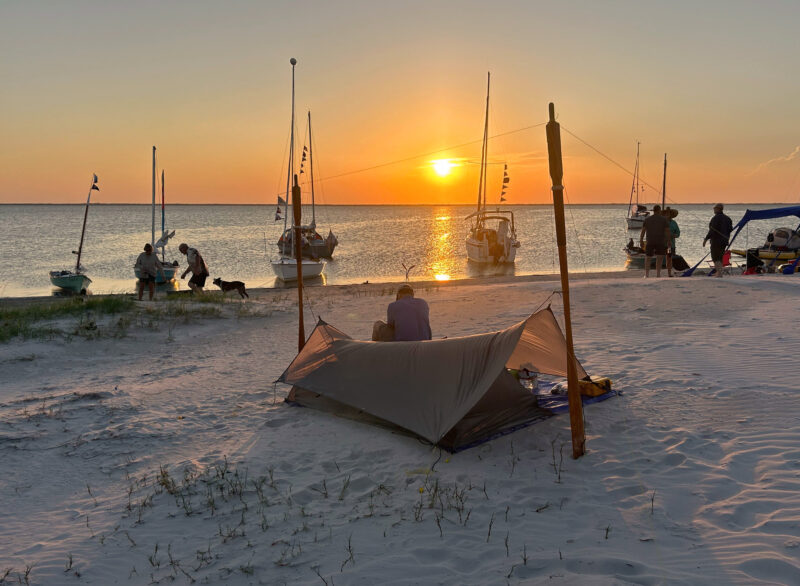 Will Robertson
Will Robertson As the sun set on Day 2, I set up camp at the Dunes. Although parts of Padre Island are occupied by condominiums, campgrounds, and miles of beach open to four-wheel-drive vehicles, much of it is a fragile ecosystem, so a leave-no-trace philosophy is a must. As long as we packed everything out and walked only on sand, one afternoon’s wind would erase all evidence of our having been there.
I caught up with SANDPIPER, a Compac Sun Cat with Bob and Lisa aboard. They had a reef tucked in and before I sailed out into the bay, I, too, took in a single reef. We sailed together across the open water: above, the sky was blue, with stretches of cumulus clouds far away above the horizon; below, the blue-gray water was traced with lines of brown revealing how shallow these waters were. The wind had freshened still more, and we shouldered through the waves, tossing foam aside as we drove into the crests and out of the troughs.
I had crossed the bay three times in previous years, but despite my experience I drifted north of the channel and the daggerboard dragged me to a stop before I got back on course.
At the far side of Baffin Bay, I rounded marker 125, where the Intracoastal Waterway (ICW) made a slight turn to the right as it left the bay behind. The wind remained fresh and, while gradually closing on Padre Island (the 130-mile-long low barrier island that separates Laguna Madre from the Gulf of Mexico), the water had waned to mostly 1′ to 2′ rolling waves. A barge was approaching from the north, and I sailed to starboard of the marked channel to stay out of its way. My daggerboard dragged me to a halt again. As the barge went on by, I pulled the board up and sailed back into the channel and the barge’s wake.
The barge cut the corner around marker 125, its path arcing across the entire football-field width of the channel, and I was glad I had stayed out of its way.
After another 3 miles, the water outside of the channel to the east opened up to a good 4′ depth most of the way to Padre Island. SANDPIPER and ARR & ARR parted ways, and I headed up as close to the wind as I could to get into the shelter of the island and reached along in the lee of its grass-knitted dunes to the second night’s camp. SANDPIPER sailed on a reach on what I assumed was a more direct route.
I landed within a cluster of 15 to 20 boats pulled up on the sandy shore beneath dunes the height of two- and even three-story houses. SANDPIPER was still well out in the Upper Laguna Madre, and I wondered that they had not turned to come in. Will and Jennifer, on COSMO CAT, a Hobie 14, explained that we were not, in fact, at the Flats, the official campsite. We were, instead, at the Dunes. Buddy, sailing GROS BEC, his modified Sweet Pea, joined us. No one, he said, with any sense passes by the Dunes; it was one of his favorite places on this coast.
I later learned that my accidental stop turned out to be fortuitous—at the official camp there was insufficient dry ground even for the remaining fleet, and they all had to find alternative spots. The Dunes, meantime, provided ample dry space and the fine-grained sand felt cool between my toes despite the heat. The other sailors and I climbed one of the tallest dunes to watch the sunset. To the east, shadows crept up through dunes. I was exhausted as I trudged down the dune and tidied up my camp.
I had launched at Port Mansfield with a little over 2 gallons in my 3-gallon water jug lashed in the sternsheets, a backup gallon jug stored in the forward compartment, and three 1-liter bottles stuffed into net pockets in the cockpit. I expected to use about a gallon per day and planned to refill at the halfway point near Corpus Christi. My goal had been to save weight wherever I could—I had even lost 10 lbs in the two months before the trip. But sitting in an open boat with neither wind nor shade, covered from head to toe with clothing and gear, I had been sweating like a soaker hose and consuming 2 gallons per day—even while trying to conserve. Yet still I was constantly thirsty.
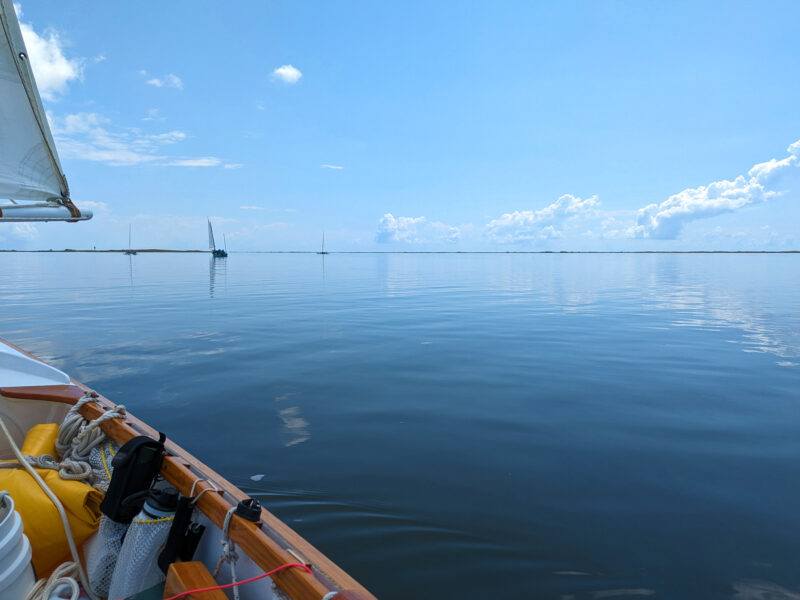 Roger Siebert
Roger Siebert As I set off from the Dunes on the morning of Day 3 it was into a mirror-flat sea. Between a quarter and half of the fleet had outboards and these were put to good use, their skippers offering tows to those of us who had no such auxiliary power. A dozen or so skippers declined the help and rowed or paddled. I don’t consider myself a purist—ARR & ARR has some stainless fittings, a satellite tracker, double-braided poly line, and a Dyneema yard parrel—but I nonetheless do enjoy the challenge of making way under only sail and oar, as long as I don’t compromise safety. Pictured here are a few boats with skippers of similar mindsets, on waters that test patience but also offer opportunity for reflection, both literally and figuratively.
The main jug and all three bottles were empty, so I pulled out my emergency gallon, chugged down half a dozen gulps, refilled one water bottle to sip from overnight, and poured a cup in the freezer bag with the evening’s dehydrated meal. I gauged the water remaining in the jug, needing a cup for breakfast, more if I wanted coffee. After flossing that evening and swirling water around in my mouth, I drank the wash instead of spitting it out. I did spit out my first toothpaste rinse but swallowed the second.
The next morning, I awoke tired and thirsty. I had breakfast, broke camp, loaded the boat, drank the last of my water, and shoved off. I was only a half day from Marker 37 Marina at Corpus Christi, so my situation was one of only discomfort and not yet an emergency.
When the morning doldrums set in, I left the sail up and rowed. After an hour of rowing, the wind began to fill in. In less than a minute I had stowed the oars, pushed down the rudder blade, and sheeted in the sail.
At 2 p.m., I reached Marker 37 Marina, dropped sail and rowed around to its landward side, my oars touching bottom several times. I tied up on that side anyway, near the end of the pier, and walked into the marina complex where I found an outdoor freshwater shower and rinsed off. At a convenience store on the pier, I bought an electrolyte drink and quickly downed it. I filled my 3-gallon jug, the 1-gallon emergency jug, and all three water bottles. Before returning to the boat, I rinsed off under the shower again and drained an ice-cold bottled water. I was ready to tackle this cruise again.
I cast off, and with the wind fresh and directly from astern, I sailed on a run under the JFK Bridge, holding a steady course leaving no room for doubt about my intentions for skippers of the few powerboats that shot past. Some 75′ overhead, tires of the vehicles crossing the bridge clacked across the expansion joints.
The deep-water channel beyond the bridge was edged to the east by an almost-continuous chain of spoil islands, their white-sand-and-shell shores topped by grasses and scrub. The deep water ran straight south to north from the bridge to Corpus Christi Bay, and I ran downwind under full sail at 5 knots, water gushing from ARR & ARR’s bow. A double-decker tourist boat approached from astern, and I hugged the right edge of the channel to let it pass. Its starboard decks were crowded with people looking in my direction, and I realized the crew were using my boat as a tourist photo op. It must, indeed, have been a sight: a tiny boat with a traditional rig sailing along, gushing foam, with two burgees flying from a pigstick at the masthead, and a 5′-long red pennant streaming from the yard’s peak.
A wide, black thundercloud was growing over Corpus Christi Bay. There was no blue sky beneath it nor a clear anvil shape at its top by which I might have gauged its direction of travel. There were only broad stretches of dark cumulonimbus clouds reaching out toward me. I soon realized that the anvil was pointed at me—the thunderstorm was coming my way.
I wanted to avoid a repetition of my Red Fish Bay experience in Corpus Christi Bay, so I looked for a place to anchor. The chart showed a small channel cutting through the spoil islands less than a mile ahead. If I could get there before the storm caught me, it looked like I would be protected from all directions.
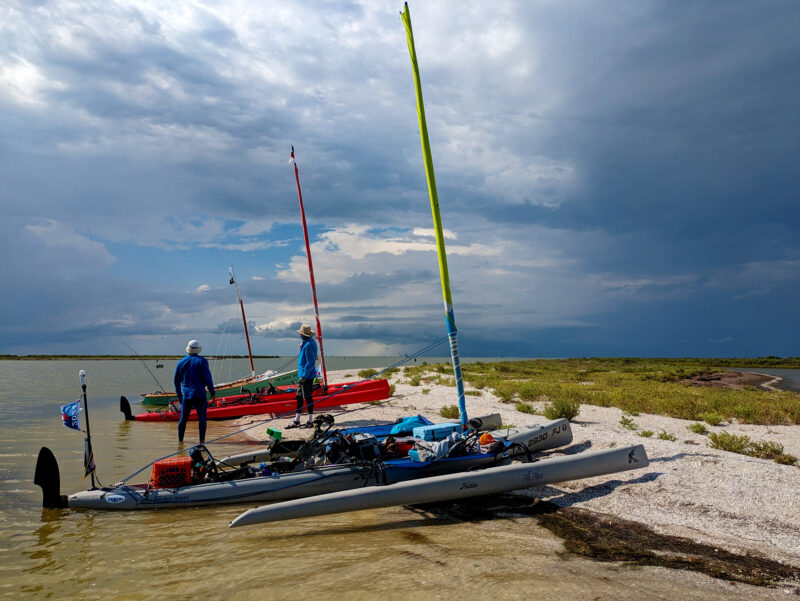 Roger Siebert
Roger SiebertAt Dead Pelican Island, Andrew (left) and Will stand between their trimarans, ALL AHOO (foreground) and OOKPIK, watching the thunderclouds forming over Corpus Christi Bay, which lies just beyond the islands visible to the left of the picture. These and other spoil islands were formed when the Intracoastal Waterway—which passes from left to right between Dead Pelican and the far spoil island—was dredged. A few of the channel’s navigational-aid buoys can be seen in the central distance. ARR & ARR lies beached beyond the two multi-hulls.
I drew near. On the far side of the small channel there appeared to be a beach. Pulling the boat onto shore would be even better than anchoring. I got closer and saw that there were two kayak trimarans already there. Company. Better still.
I got up as much speed as I could, turned ARR & ARR toward the beach, and when I was about 15 yards offshore, I pulled up the daggerboard and let the sail luff. The two trimaran skippers stood ready to catch me, but ARR & ARR came to a graceful hissing stop all on her own. I stepped out and set my anchor about 15′ up the beach.
The wind grew stronger, the sky blacker. Expecting rain, Will, skipper of the pedal-and-sail Hobie Tandem Island OOKPIK, suggested setting up camp immediately. I pitched my bivy across the wind, deciding it would be better to lose the cooling breeze but keep the rain out. I staked the fly’s windward edge tight against the ground. The wind pressed it into a concave scoop, but the rain never came. The thunderstorm blew itself out, but by then not enough daylight remained to tackle Corpus Christi Bay. Instead, I sat and chatted with Will and with Andrew, skipper of the other Hobie Tandem Island, ALL AHOO. They shared anchovy-stuffed olives, pan-seared Gouda cheese, salami, and homegrown cherry tomatoes in a vinaigrette dressing.
As the evening light waned, nighthawks called overhead, their cries like suddenly overloaded drags on fishing reels, and we retired to our tents. The wind stayed strong and pressed the fly against me inside the bivy. I was tired, though, and being hydrated once again, looked forward to the rest.
In the morning, Will and Andrew loaded their boats and set off on their way back toward the JFK Bridge. They had decided to pull out of the event, their knees having had their fill of pedaling through the last three mornings. It took me another hour to break camp and load ARR & ARR, but by the time I left, Will and Andrew were still in sight. It was yet another doldrums morning.
Being now so far behind the rest of the fleet and on my own, I no longer needed to save my best rowing for farther along the route. So, I rubbed anti-chafe balm across my armpits and changed into a long-sleeved UV-blocking shirt, a pair of poly-spandex-mix rowing shorts, and my clean convertible pants. The pants were normally snug, but now they settled a full 2″ beneath my waist, an indication of just how much weight I’d lost. I pulled a belt from my bag and snugged the pants in place.
The water stirred in tiny ripples. For two hours I sailed at about 2 knots, until I reached Shamrock Island, where gulls, terns, and egrets jostled above and crowded the beach and filled the air with a cacophony of calls.
The wind died. The heat was relentless. I had covered just half of Corpus Christi Bay, was exhausted, and hadn’t even rowed yet. There were 4 miles of bay yet ahead of me, followed by another 4 miles up the ship channel to Port Aransas, and another 6 miles to Mud Island, where the rest of the fleet had presumably stopped the night before. I readied the boat for rowing and decided to drop out at Port Aransas.
After a couple of hours of rowing, my hands and rear were sore. I had averaged little more than 1 knot. On my local lake, I can average 3 knots for hours on end including water breaks. But here I was exhausted and had taken so many breaks.
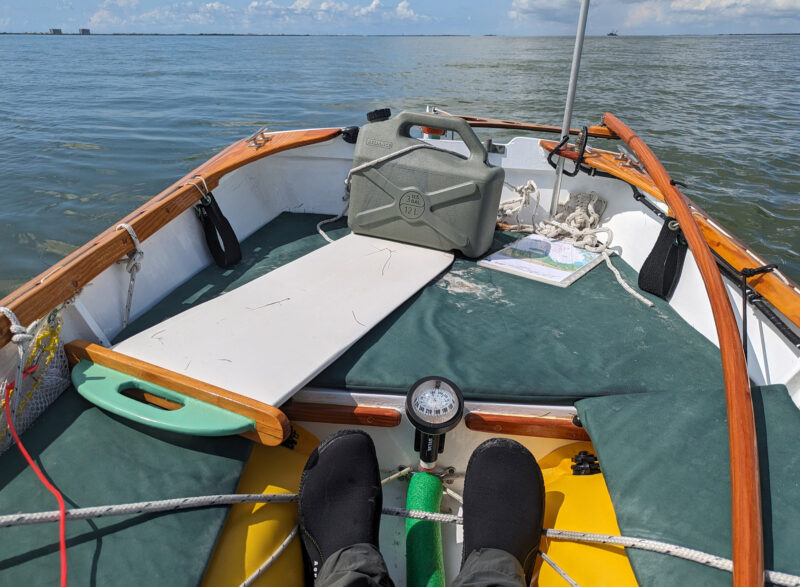 Roger Siebert
Roger SiebertI left Shamrock Island under oars, having pulled the daggerboard out and inserted the rowing plug into its slot. I had mounted a bracket on the sternsheets just aft of my feet so I could move the hand-held bulkhead-mounted compass aft when rowing. It wasn’t a rowing compass, so I had to add 180 degrees to the reading to determine my heading. For a foot brace I tied a length of braided line between the inwales, and to keep the rudder centered I fastened the push-pull tiller with shock cord to the inwale, which also prevented the extension from swinging around and dragging behind the boat. My primary means of navigation was a NOAA chart booklet that I downloaded, printed, laminated, and bound. By this stage in the voyage, I had organized my gear so that it mostly fit inside the buoyancy compartments. The 3-gallon can of drinking water was lashed to the transom.
I pulled off my gloves so that my grip would pressure different parts of my hands and slid my pants down to my upper thighs, where they would still block the sun and I’d have only my seamless rowing shorts between me and the seat pad. I was pain-free again and rowed on for another hour and a half, until I reached Point of Mustang at the northwest tip of Mustang Island.
I beached the boat on the south side of the point’s hook so that the wakes of freighters and barges passing through the channel on the other side wouldn’t toss it around. After I dropped my PFD and harness in the boat, I plopped in the water. It was warm but refreshing. I poured water over my head and face. I stood up, completely soaked, and the slight breeze felt cool on my skin.
I spent nearly an hour at the point, psyching myself up for the possibility of a 4-mile row up the channel to Port Aransas Harbor. I floated in the bay, drank water and snacked, and stood in ankle-deep water to let the growing breeze cool me off.
By the time I was ready to leave, the breeze had become steady and strong. I decided to sail instead of row and began to think I might continue past Port Aransas after all.
A steady stream of tankers, spaced at about 20-minute intervals, powered down the channel from the Gulf. I stayed mainly on the southern side of the channel, tacking between it and the shoreline, heading into the channel only after a tanker had passed so I could attack its wake with my bow.
After four tankers had passed, the channel ahead appeared clear, but a fifth tanker approached from the opposite direction. I used the same tactic, staying close into shore, allowing the tanker to pass and then, just as I was about to tack out to meet its wake, I heard a hissing roar to starboard. Just 30 yards away, a 4′ wave breaking along the shore was barreling down on me. I turned hard to port just in time to come stern-to the wave. In the seconds before it reached me it settled into a swell—I had apparently reached deeper water.
When the tankers and barges were gone, I had the channel to myself. Ahead, the water churned in flat splashing pools 10- to 20-yards across, disturbed by schools of feeding fish. Stark black-and-white terns with forked tails spun above the churning pools, and dove within a fraction of an inch of the water’s surface, but none were leaving with fish; they must have been feeding on the insects that had attracted the fish.
I was making good time and set my course to cross the paths of the Port Aransas ferries in a single tack. They paused in their 1⁄4-mile crossings until I was clear. I turned to port and fell off on a broad reach, leaving Port Aransas behind.
For the first 4 miles or so, the channel from Port Aransas—past the Lydia Ann Lighthouse and toward Mud Island—cuts through shoals. Within the first mile, I passed a line of barges tied along the edge of the channel across from the lighthouse. The tug that had been closing on me during my approach to Port Aransas came around the point and continued down the channel, gaining on me quickly.
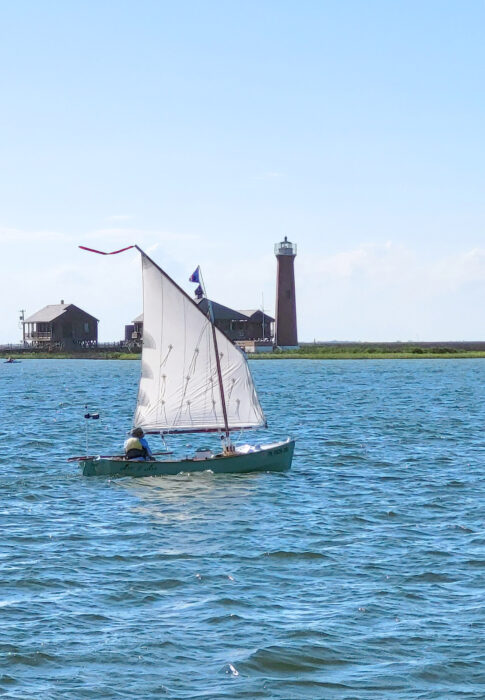 Brian Graham
Brian Graham With the land around the Intracoastal Waterway so low and flat, any prominent building becomes a useful navigational aid. We sailed past the Lydia Ann Lighthouse, down the channel of the same name, leaving Port Aransas about a mile behind and heading toward Mud Island. Previously called the Aransas Pass Light Station, the lighthouse was deactivated in 1952 after the shifting sands of San Jose and Mustang islands pushed the Aransas Pass south by more than a mile over the course of a century. The lighthouse and its surrounding structures are currently maintained as a historic site.
I pulled the daggerboard up halfway and moved to the west side of the channel. I had grounded there on past trips, and as expected, touched bottom again. I pulled the daggerboard up the rest of the way, got moving again, put the board back down, grounded, pulled out the board, moved, grounded, pulled up, again and again.
Another tug approached from the north. As the two drew near each other they slowed and, moving at a snail’s pace, took an excruciatingly long time to pass each other and me. When they were gone, I was free to sail back into the channel and run with the wind. It was wonderful sailing with the late evening light casting the water in tones of blue gray. As ARR & ARR charged across rolling waves I steered with both hands on the tiller, on the edge of control. The wake was all foam. It was exhilarating and I was filled with more energy than the morning’s doldrums had drained.
As I passed the southern tip of Mud Island, I pushed the daggerboard down and headed up on a close reach. In the lee of the island, the waves subsided, though the wind stayed strong, coming as it did across the island’s waist-high mangroves. A narrow beach of sand and bleached shells was mottled by malty brown wrack. Expecting shallows even a hundred yards out, I raised the daggerboard 12″, pointed up to a close haul, and aimed for the landing I had picked out.
About 30 yards off the beach, the rudder blade bumped and scraped. I pulled the daggerboard and shoved it into the sternsheets. I continued on a close haul but slid as much to leeward as I sailed forward.
What had been almost flat water between me and the island suddenly erupted into a churning wave barely a yard from the boat: redfish, spooked at the last minute by my approaching boat.
I had raised the rudder blade as much as I could without losing steerage, but in the end, it was the keel that stopped the boat, grinding into the sand and patches of seagrass. I stepped out into just 6″ of water, grabbed the bowline, and pulled the boat toward shore. The roiling fish stayed with me, preceding my every step and only scattering off to either side when I was within three steps of shore.
The low sun cast both water and island in an orange glow and a scant half-moon hung high in the sky. The air was cooler than on any of the three previous evenings. I felt good—tired and hungry but relaxed and accomplished. Everything had turned out perfectly after having spent a couple of evenings in the company of likeminded people and now alone on an island in a warm bay on a summer evening. Although I was leaving the Texas 200, it felt exactly right to be where I was and to have arrived when I did. I felt no need to reach the official finish line. My finish line was governed by time: It was Thursday, and I had to be at work on Tuesday; I had reserved Sunday and Monday for cleanup and rest.
I wanted only to eat and settle into the boat to sleep, but I had spotted some brackish pools barely 20 yards from where I’d landed and knew that I’d be attacked by mosquitoes after midnight. I pulled ARR & ARR farther onto shore, and with the keel settled in the furrow it had plowed, the boat was steady and upright. I slid the side seats into the middle of the cockpit and set up the mesh bivy in the boat, tying its lines to the mast, the stern light pole, and a camera boom set in the sternsheets. I was done in half the time it would have taken to set the bivy up onshore with the oars as poles.
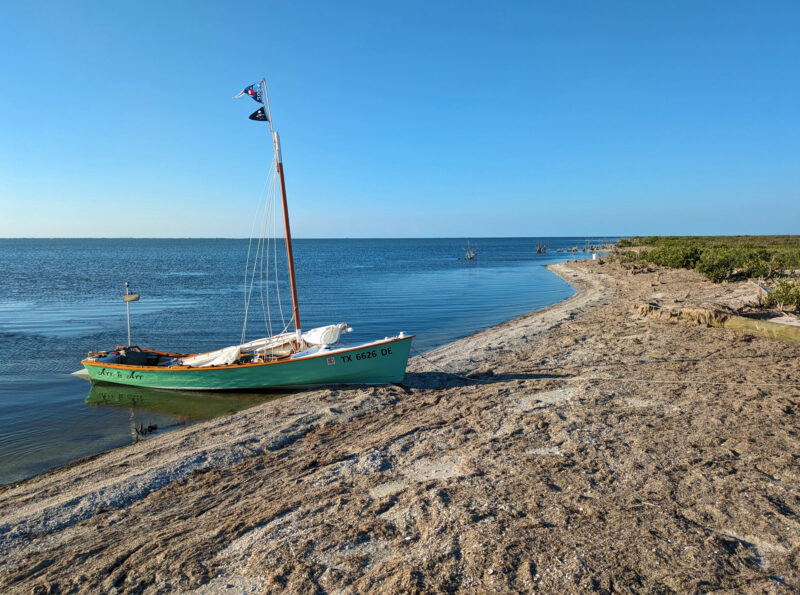 Roger Siebert
Roger Siebert I beached ARR & ARR for the night on the leeward side of Mud Island and set her anchor on the inland side of a washed-up piling, being careful to lay the chain part of the rode over the piling to avoid chafing the nylon rode. In the far distance the mainland was just visible on the horizon and with the late hour the wind and water had stilled. Moments like this draw me to the Texas coast again and again.
To make space for my sleeping arrangements, I laid the folded tarp on shore as a base for everything that needed to come off the boat: water jug and bottles, bucket head, camping dry bag, and electronics and recharging gear. As the sun set and the moon rose, the nighthawks took to the skies. There was no wind and the netting stayed in place above me, catching the moonlight and casting mesmerizing multi-colored moiré patterns over my head. The slight night breeze was refreshing, and I fell right to sleep.
Packing in the morning was also quicker without the oar setup, and I was able to take advantage of the gentle, early-morning breeze. There were still 60 miles to go to get to my car and trailer. It was Friday, the official finish. I might be able to make it on Saturday, but it would be tight. I needed to replenish my water supply, so I steered across the mouth of Aransas Bay to Rockport instead of through the bays and cuts toward Army Hole, which had been the official campsite for the previous night. I sailed beneath the cumulus-dotted blue sky on the gently rippling blue-green water. It was a slow but pleasant sail. Another cannonball jellyfish, this one the size of a large grapefruit or small melon, appeared alongside the boat, but this time I was the one moving faster.
The wind was favorable for sailing into Little Bay at Rockport through its southern channel, so I didn’t switch to oars until I was well inside where buildings blocked much of the wind. None of the marinas in the harbor had any indication that they were anything other than private until I came to a building no bigger than a two-car garage that advertised boat rentals. I rowed close, and a man asked if he could help me. I told him I was looking for a marina where I could top off my drinking water and recharge my power packs. He said he only rented boats but that I was welcome to use his hose. I did so, thanked him, and asked where such a marina might be. A few miles south, he said, or a mile or so north, in Fulton. I didn’t want to backtrack, so I opted for north. The chart indicated a low fixed bridge spanning the 20-yard-wide channel at the north end of Little Bay, and the man wasn’t sure my mast would clear, even with the sail and yard lowered. I unstepped the mast and set off rowing. I passed beneath the bridge, which would indeed have been too low for my mast, and I was in Aransas Bay again.
I had drinking water now and the boat’s battery was still fully charged, and although I would have welcomed a cold drink and a sandwich, I had food aboard to last a couple of days. I continued rowing out into the bay until I had enough sea room to set my rig back up and proceeded on my way under sail.
I had to work upwind to make it back into Aransas Bay far enough to get around Blackjack Peninsula, 7 miles to the north-northwest. It was a beautiful day, though, with light green water—almost luminous—and enough wind to drive ARR & ARR at nearly hull speed. I made good headway, but by 3 p.m. the channel markers were still tiny on the horizon. Even if I followed the ICW to Matagorda Bay instead of going through the cuts and islands, I wasn’t going to make it to the event’s finish at Magnolia Beach on Saturday unless I sailed at night. It wasn’t an option. I had running lights but didn’t have the experience to be safe, especially as exhausted as I was.
I needed to pull out while there were still Texas 200 volunteers taking calls. If I called on Sunday, two days after the official finish, a volunteer would probably still offer a ride, but it would surely not have been in their plans.
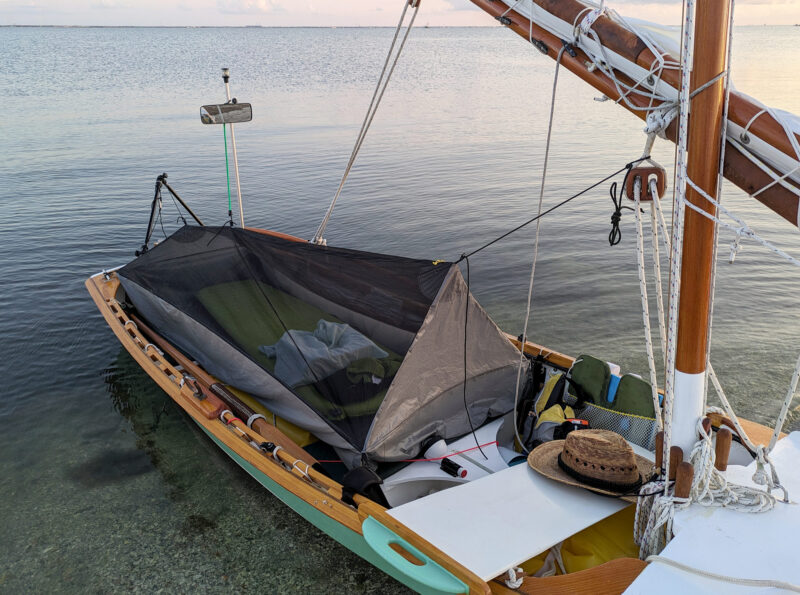 Roger Siebert
Roger Siebert The net bivy fit neatly inside ARR & ARR, the height of its waterproof bathtub bottom almost exactly matching the height of the gunwales above the seats. I entered through the head. The foam pillow inside the bivy could compress to the size of a softball to fit in a stuff sack.
I fell off, jibed around, and sailed back on a run toward the marina in Fulton. Huge powerboats and red and green markers atop pilings made it easy to spot at a distance without the aid of charts or electronics. ARR & ARR surfed down the waves with wide fans of foam. Before long, the conditions were too much. The wind and waves tried to broach my boat, so I headed up, set a reef, and continued the run downwind. It was still too much. I barely maintained control even with both hands on the tiller. I headed up again, set a second reef, and continued toward the marina breakwater.
ARR & ARR still surfed down each wave, but the force on the tiller was now manageable. Water roared away from her bow and gunwales, and I kept her pointed at the harbor’s entrance. When I reached the breakwater, I turned to starboard into its shelter. The wind stayed strong, but the water was flat inside. I sailed the full length of the harbor but saw no signs of a marina where I could rent a slip. I came about and worked my way back toward the breakwater’s entrance. A few workers had watched me come in. Two of them sat in the shade at a bait shop on the waterfront. I dropped sail and rowed to them.
“Hello,” I said. “Do you know where I can tie up for a few hours, maybe overnight?”
One pointed to an empty spot on one of the docks.
“Twenty dollars if overnight,” he said.
I said, “That’s fine. Thank you.”
“You were really moving out there,” he said. And with that, both men rose and walked around to where he had pointed.
“I’m John,” he said, as he took my stern line and tied it to one of the dock’s cleats. The other man tied my bowline to another.
John, looking at my PFD with its VHF radio, dive knife, and satellite tracker, said, “You have all the safety gear, for sure.”
“Yes,” I said as I climbed onto the dock. “You guys are really life-savers.”
On my cell phone, I called Sharon, one of the Texas 200 volunteers. It would be an hour before she would arrive so I tidied up the boat, pulled out what I wanted to take with me, and secured the rest. John and his friend had to leave and their place was taken by another man who arrived by car and came over to ask what I and my little pile of gear were about. I told him about John and our deal. He nodded, gave me a beer, and joined me to chat about boats (me) and surfing (him).
Sharon and Ziggy arrived and reunited me with my car and trailer in Magnolia Beach, but by the time I got back to Fulton it was evening, and I was too exhausted to drive back to Austin and home, so I got a hotel room.
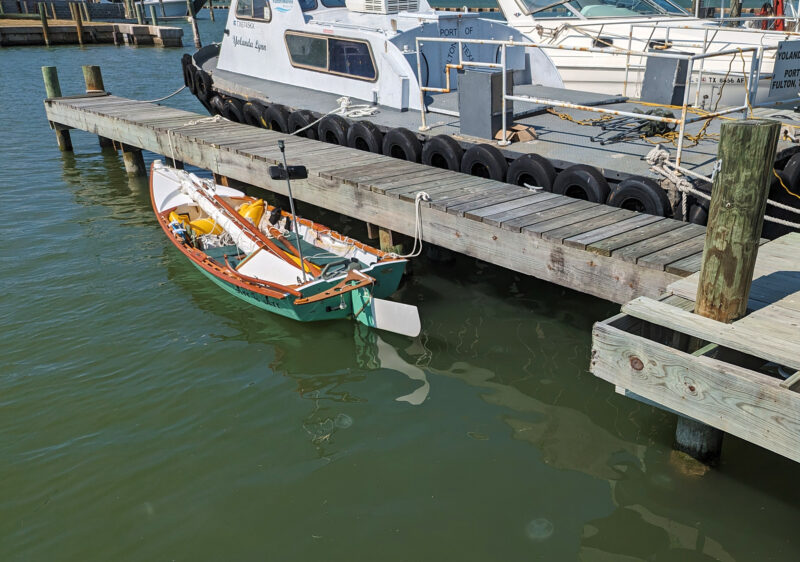 Roger Siebert
Roger Siebert Before I left ARR & ARR to go back and retrieve the trailer, I de-rigged her, removed the daggerboard, and raised the rudder so that she was all ready to pull out. I locked the compass, VHF radio, satellite tracker, and other valuables out of sight for the night, but was unconcerned—the docks were on the other side of a locked security gate and ARR & ARR was in the company of boats worth many thousands of dollars more than her.
The following morning, I pulled the boat out at the adjacent ramp where the water was thick with moon jellyfish, their flat transparent bells showing opaque four-leaf-clover shapes in their centers. I found John lying in a hammock in the shade of the bait shop’s shelter and thanked him again for the help he and his friend had offered. He shook my hand and wished me well.
It had been a wonderful five days, challenging me and my boat, and allowing me to meet all sorts of people that made the venture worthwhile. But I also had time by myself on this perfect stretch of coast: sheltered, often gentle, occasionally unpredictable, and typically uncrowded. I would be back—better prepared, more experienced, and open to whatever the Texas coast would share with me next time.![]()
Roger Siebert is an editor in Austin, Texas. He rows and sails ARR & ARR on local lakes, and has trailered her to a few of his favorite places on the Florida coast.
If you have an interesting story to tell about your adventures with a small boat, please email us a brief outline and a few photos.
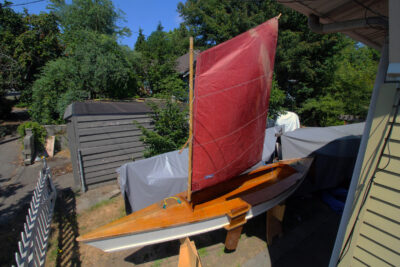
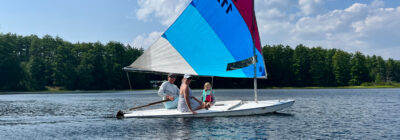
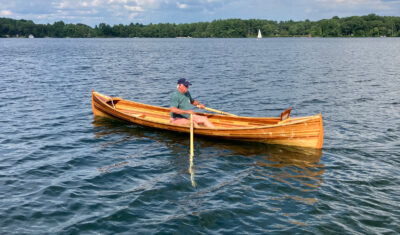
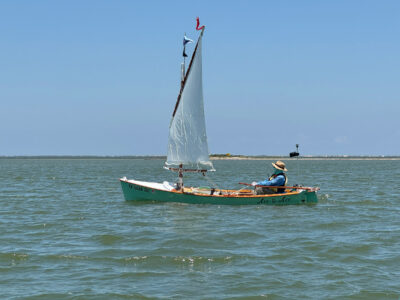
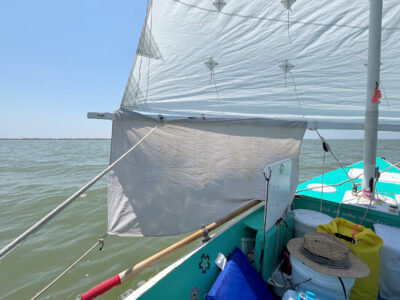
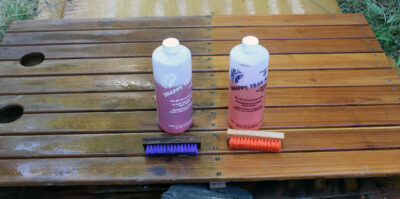
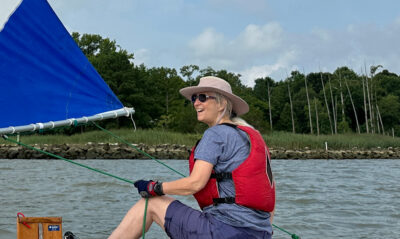
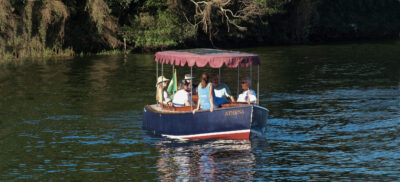
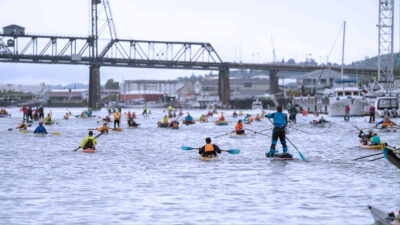

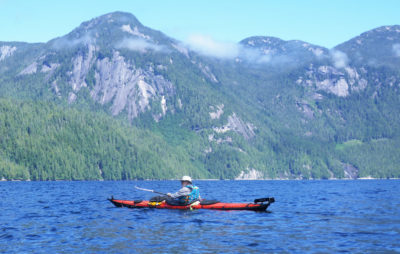
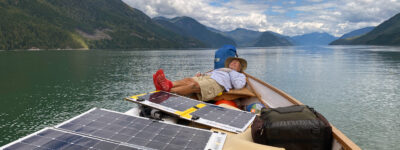
Great tale! Well done.
Thank you, Robert.
Well done, and thank you for sharing. I enjoyed reading your story.
Thank you, Mark.
Always enjoy reading tales from the 200. Completed myself, 2016 I think, in a Mayfly 14. Thanks for sharing.
Thanks, Paul. A Mayfly is perfect for the Texas 200. Great choice!
Hi Paul,
Wondering if you would care to comment on the relative advantages of your tiller set up. I have a Flint in Tasmania.
Cheers,
David
Hi, David. Thanks for reading. Always a pleasure to find another Flint owner.
I use the standard tiller from the Flint’s design with an extension when daysailing alone. The push-pull tiller, though, opens up the sternsheets for a passenger or, for multiday excursions, for gear that might stick a bit above the top edge of the transom. It’s also a nice area for a foldable backpacker’s solar panel that gets little spray and, with the push-pull tiller, no shadow. And if I need to shift weight aft, with the push-pull tiller, I can just plop back there myself.